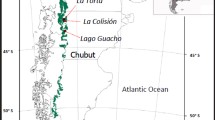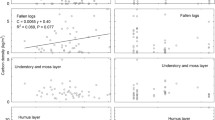Abstract
Deforestation in the Brazilian Amazon has resulted in the conversion of >230,000 km2 of tropical forest, yet little is known on the quantities of biomass consumed or the losses of nutrients from the ecosystem. We quantified the above-ground biomass, nutrient pools and the effects of biomass burning in four slashed primary tropical moist forests in the Brazilian Amazon. Total above-ground biomass (TAGB) ranged from 292 Mg ha-1 to 436 Mg ha-1. Coarse wood debris (>20.5 cm diameter) was the dominant fuel component. However, structure of the four sites were variable. Coarse wood debris comprised from 44% to 69% of the TAGB, while the forest floor (litter and rootmat) comprised from 3.7 to 8.0% of the TAGB. Total biomass consumption ranged from 42% to 57%. Fires resulted in the consumption of >99% of the litter and rootmat, yet <50% of the coarse wood debirs. Dramatic losses in C, N, and S were quantified. Lesser quantities of P, K, and Ca were lost by combustion processes. Carbon losses from the ecosystem were 58–112 Mg ha-1. Nitrogen losses ranged from 817 to 1605 kg ha-1 and S losses ranged from 92 to 122 kg ha-1. This represents losses that are as high as 56%, 68%, and 49% of the total above-ground pools of these nutrients, respectively. Losses of P were as high as 20 kg ha-1 or 32% of the above-ground pool. Losses to the atmosphere arising from primary slash fires were variable among sites due to site differences in concentration, fuel biomass, and fuel structure, climatic fluctuations, and anthropogenic influences. Compared to fires in other forest ecosystems, fires in slashed primary tropical evergreen forests result in among the highest total losses of nutrients ever measured. In addition, the proportion of the total nutrient pool lost from slash fires is higher in this ecosystem compared to other ecosystems due to a higher percentage of nutrients stored in above-ground biomass.
Similar content being viewed by others
References
Agee JK, Huff MH (1987) Fuel succession in a western hemlock/Douglas-fir forest. Can J For Res 17: 697–704
Bowen HJM (1979) Environmental chemistry of the elements. Academic Press, London
Brazil DNPM (1978) Projeto RADAMBRASIL. Folha SC.20-Porto Velho; Geolgia, geomorfolgia, pedologia, vegetacao e uso potencial da terra. (Vol 16) Depto. Nac. da Producao Mineral, Rio de Janciro, Brazil
Bremmer JM, Mulvancy CS (1982) Total nitrogen. In: Page AL, Miller RH, Kenney DR (eds) Methods of soil analysis, part 2. Agron Monogr 9: 595–624
Brown JK, Roussopoulous PJ (1974) Eliminating biases in the planar intersect method for estimating volumes of small fuels. For Sci 20: 350–356
Brown S, Lugo AE (1992) Aboveground biomass estimates for tropical moist forests of the Brazilian Amazon. Interciencia 17: 8–18
Bruijnzeel LA (1991) Nutrient input-output budgets of tropical forest ecosystems: a review. J Trop Ecol 7: 1–24
Crutzen PJ, Andreae MO (1990) Biomass burning in the tropics: impact on atmospheric chemistry and biogeochemical cycles. Science 250: 1669–1678
Cummings DL, Kauffman JB, Castro EA, Filguireras TS (1993) Autogenic relationships between communilty structure and fire behavior in the Brazilian Cerrado. Bull. Ecol. Soc. Am. 74: 205
Davies BE (1974) Loss on ignition as an estimate of soil organic matter. Soil Sci Soc Am Proc 38: 150–151
Departamento Nacional de Metrologia-Brasil (1992) Normais climatologicas (1961–1990). Ministerio da Agricultura e Reforma Agraria, Brasilia, DF Brasil
Deeming JE, Burgan RE, Cohen JD (1977) The national fire danger rating system — 1978 USDA For Serv Gen Tech Rep INT-39, Ogden, Utah
Deevey ES Jr (1970) Mineral cycles. In: The biosphere. Freeman, San Francisco
Detwiller RP, Hall CAS (1988) Tropical forests and the global carbon cycle. Science 239: 42–47
Eiten G (1983) Classificacao da Vegetacao do Brasil. CNPq/Coordenacao Editorial, Brasilia, DF Brasil
Ewel J, Berish C, Brown B, Price N, Raich J (1981) Slash and burn impacts on a Costa Rican wet forest site. Ecology 62: 876–879
Feller MC (1989) Estimation of nutrient loss to the atmosphere from slash burns in British Columbia. In: MacIver DC, Auld H, Whitewood R (eds) Proceedings of the 10th Conference on Fire and Forest Meteorology, Forestry Canada, Chalk River, Ontario, pp 126–135
Fearnside PM (1992) Carbon emissions and sequestration in forests: case studies from seven developing countries. 2. Brazil. U.S. Environmental Protection Agency, Climate Change Division, Washington, DC
Fearnside PM, Leal N, Fernandes FM (1993) Rainforest burning and the global carbon budget: biomass, combustion efficiency and charcoal formation in the Brazilian Amazon. J Geophys Res 98: 16,733–16,743
Grier CC, Logan RS (1977) Old growth Pseudotsuga menziesii communities of a western Oregon watershed: biomass distribution and production budgets. Ecol Monogr 47: 373–400
Houghton RA (1991) Biomass burning from the perspective of the global carbon cycle. In: Levine JS (ed) Global Biomass buring. The MIT press, Cambridge MA, USA
Jordan CF (1982) The nutrient balance of an Amazonian rain forest. Ecology 63: 647–654
Jordan CF, Uhl C (1978) Biomass of a “tierra fire” forest of the Amazon Basin. Oecol Plant 13: 387–400
Kauffman JB, Uhl C, Cummings DL (1988) Fire in the Venezuelan Amazon. 1. Fuel biomass and fire chemistry in the evergreen rainforest of Venezuela. Oikos 53: 167–175
Kauffman JB, Till KM, Shea RW (1992) Biogeochemistry of deforestation and biomass burning. In: Dunnett DA, O'Brien RJ (eds) The science of global change: the impact of human activities on the environment. American Chemical Society Symposium, series 483. American Chemical Society, Washington, DC, pp 426–456
Kauffman JB, Sanford RL, Cummings DL, Salcedo IH, Sampaio EVSB (1993) Biomass and nutrient dynamics associated with slash fires in neotropical dry forests. Ecology 74: 140–151
Kauffman JB, Cummings DL, Ward DE (1994) Relationships of fire, biomass and nutrient dynamics along a vegetation gradient in the Brazilian Cerrado. J Ecol 82: 519–531
Kauffman JB, Hughes RF, Cummings DL, Ward DE (1995) Biomass burning and carbon dynamics along anthropogenic disturbance gradients in the Amazon Basin. Abstracts — Chapman conference on biomass burning and global change. American Geophysical Union, Washington, DC
Little SN, Ohmann JL (1988) Estimating nitrogen lost from forest floor during prescribed fires in Douglas-fir/western hemlock clearcuts. For Sci 34: 152–164
Martinelli LA, Victoria RL, Moreira MZ, Arroda G, Brown IF, Ferreira CAC, Coelho LF, Lima RP, Thomas WW (1988) Implantacao de parcelas para monitoreamento de dinamica florestal na area de protecao ambiental, UHE Samuel, Rondonia: Relatorio preliminar (unpublished report) Centro de Energia Nuclear na Agricultura (CENA), Piracicaba, Sao Paulo, Brazil
Medina E, Cuevas E (1989) Patterns of nutrient accumulation and release in Amazonian forests of the Upper Rio Negro Basin. In: Proctor J (ed) Mineral, nutrients in tropical forest and savanna ecosystems. Blackwell, Oxford
Nelson DW, Sommers LE (1982) Total carbon, organic carbon and organic matter. In: Page AL, Miller RH, Keeney DR (eds) Methods of soil analysis. 2. Chemical and microbiological properties, 2nd edn. Soil Science Society of America, Madison, Wis
Pyne S (1984) Introduction to wildland fire-fire management in the United States. Wiley, New York
Skole D, Tucker C (1993) Tropical deforestation and habitat fragmentation in the Amazon: satellite data from 1978 to 1988. Science 260: 1905–1910
Tabatabai MA, Bremmer JM (1970) A simple turbidimetric method of determining total sulfur in plant materials. Agron J 62: 805–806
Uhl C, Kauffman JB (1990) Deforestation, fire susceptibility, and potential tree responses to fire in the eastern Amazon. Ecology 71: 437–449
Uhl C, Kauffman JB, Cummings DL (1988) Fire in the Venezuelan Amazon. 2. Environmental conditions necessary for forest fires in the evergreen rainforest of Venezuela. Oikos 53: 176–184
Van Wagner CE (1968) The line intersect method in forest fuel sampling. For Sci 14: 20–26
Vitousek PM, Sanford RL (1986) Nutrient cycling in moist tropical forest. Annu Rev Ecol Syst 17: 137–167
Watanabe FS, Olsen SR (1965) Test of an ascorbic acid method for determination of phosphorus in water and NaHCO3 extracts from soil. Proc Soil Sci Soc Am 29: 677–678
Author information
Authors and Affiliations
Corresponding author
Rights and permissions
About this article
Cite this article
Kauffman, J.B., Cummings, D.L., Ward, D.E. et al. Fire in the Brazilian Amazon: 1. Biomass, nutrient pools, and losses in slashed primary forests. Oecologia 104, 397–408 (1995). https://doi.org/10.1007/BF00341336
Received:
Accepted:
Issue Date:
DOI: https://doi.org/10.1007/BF00341336




